University Macroeconomics Policy Brief: Australia's Economic Analysis
VerifiedAdded on 2022/11/24
|8
|1493
|146
Report
AI Summary
This report presents a macroeconomic analysis of Australia, focusing on the Consumer Price Index (CPI) and Gross Domestic Product (GDP) to assess the country's economic health. The analysis reveals that while the CPI is below the target inflation rate, GDP growth is below the average trend. The report examines both short-run and long-run economic trends, highlighting changes in consumption, investment, and trade balance. Based on this assessment, the report recommends expansionary fiscal and monetary policies to stimulate economic growth and maintain price stability. The economic rationale behind these recommendations involves increasing government expenditure on infrastructural development and maintaining a low cash rate to boost investment and aggregate demand, ultimately aiming to improve both GDP and the price level. The report underscores the importance of these macroeconomic indicators in formulating effective policy interventions.
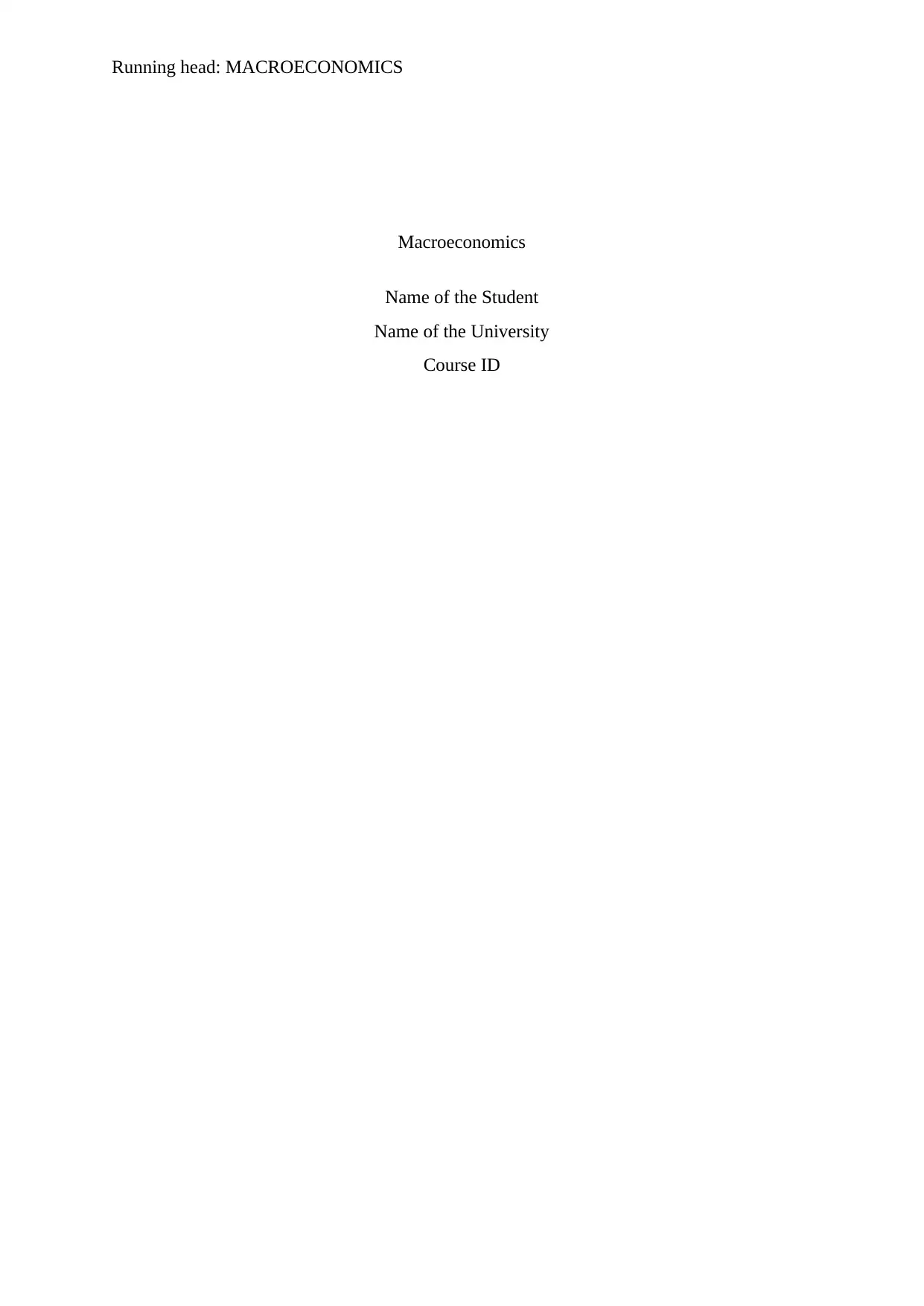
Running head: MACROECONOMICS
Macroeconomics
Name of the Student
Name of the University
Course ID
Macroeconomics
Name of the Student
Name of the University
Course ID
Paraphrase This Document
Need a fresh take? Get an instant paraphrase of this document with our AI Paraphraser
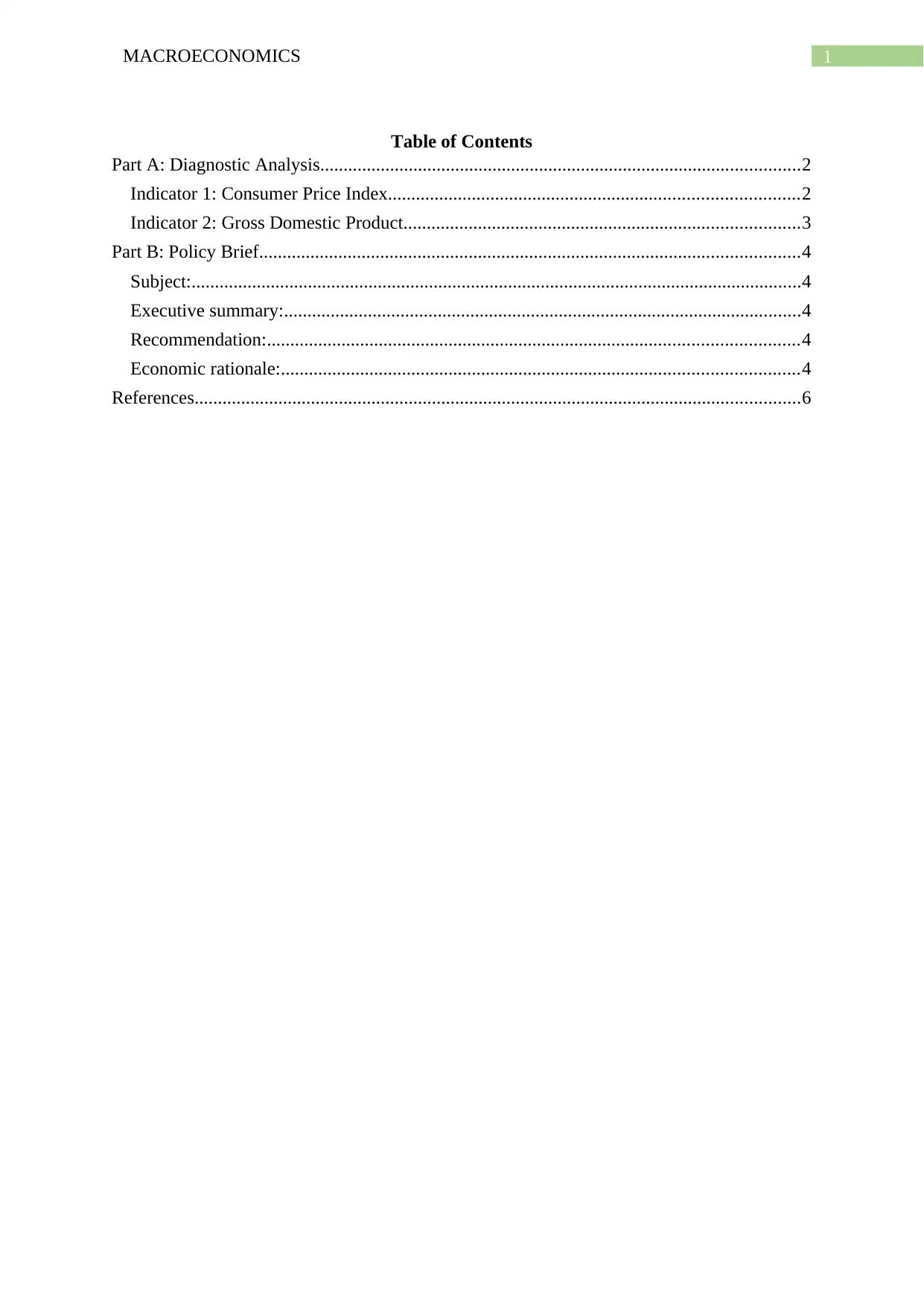
1MACROECONOMICS
Table of Contents
Part A: Diagnostic Analysis.......................................................................................................2
Indicator 1: Consumer Price Index........................................................................................2
Indicator 2: Gross Domestic Product.....................................................................................3
Part B: Policy Brief....................................................................................................................4
Subject:...................................................................................................................................4
Executive summary:...............................................................................................................4
Recommendation:..................................................................................................................4
Economic rationale:...............................................................................................................4
References..................................................................................................................................6
Table of Contents
Part A: Diagnostic Analysis.......................................................................................................2
Indicator 1: Consumer Price Index........................................................................................2
Indicator 2: Gross Domestic Product.....................................................................................3
Part B: Policy Brief....................................................................................................................4
Subject:...................................................................................................................................4
Executive summary:...............................................................................................................4
Recommendation:..................................................................................................................4
Economic rationale:...............................................................................................................4
References..................................................................................................................................6
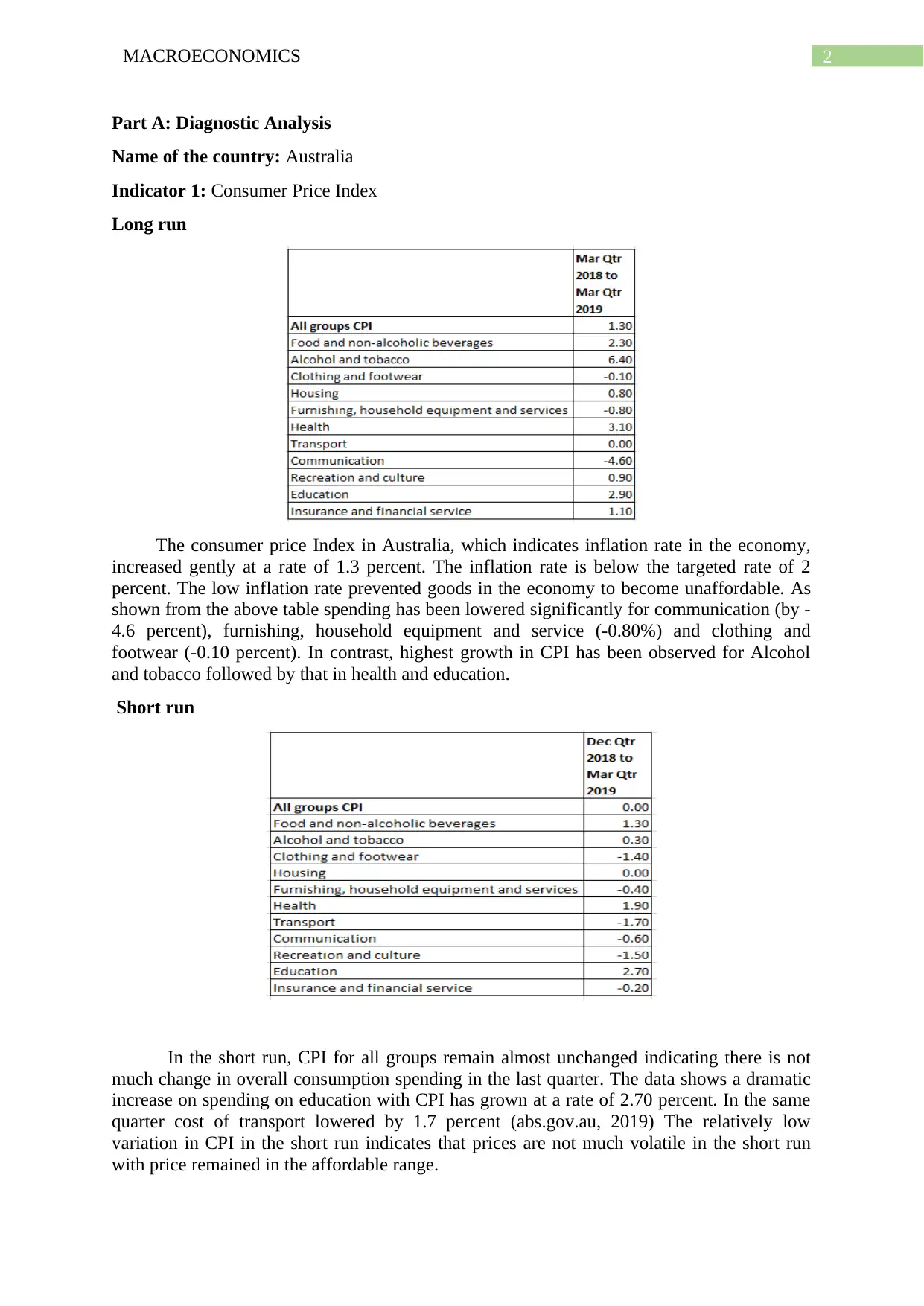
2MACROECONOMICS
Part A: Diagnostic Analysis
Name of the country: Australia
Indicator 1: Consumer Price Index
Long run
The consumer price Index in Australia, which indicates inflation rate in the economy,
increased gently at a rate of 1.3 percent. The inflation rate is below the targeted rate of 2
percent. The low inflation rate prevented goods in the economy to become unaffordable. As
shown from the above table spending has been lowered significantly for communication (by -
4.6 percent), furnishing, household equipment and service (-0.80%) and clothing and
footwear (-0.10 percent). In contrast, highest growth in CPI has been observed for Alcohol
and tobacco followed by that in health and education.
Short run
In the short run, CPI for all groups remain almost unchanged indicating there is not
much change in overall consumption spending in the last quarter. The data shows a dramatic
increase on spending on education with CPI has grown at a rate of 2.70 percent. In the same
quarter cost of transport lowered by 1.7 percent (abs.gov.au, 2019) The relatively low
variation in CPI in the short run indicates that prices are not much volatile in the short run
with price remained in the affordable range.
Part A: Diagnostic Analysis
Name of the country: Australia
Indicator 1: Consumer Price Index
Long run
The consumer price Index in Australia, which indicates inflation rate in the economy,
increased gently at a rate of 1.3 percent. The inflation rate is below the targeted rate of 2
percent. The low inflation rate prevented goods in the economy to become unaffordable. As
shown from the above table spending has been lowered significantly for communication (by -
4.6 percent), furnishing, household equipment and service (-0.80%) and clothing and
footwear (-0.10 percent). In contrast, highest growth in CPI has been observed for Alcohol
and tobacco followed by that in health and education.
Short run
In the short run, CPI for all groups remain almost unchanged indicating there is not
much change in overall consumption spending in the last quarter. The data shows a dramatic
increase on spending on education with CPI has grown at a rate of 2.70 percent. In the same
quarter cost of transport lowered by 1.7 percent (abs.gov.au, 2019) The relatively low
variation in CPI in the short run indicates that prices are not much volatile in the short run
with price remained in the affordable range.
⊘ This is a preview!⊘
Do you want full access?
Subscribe today to unlock all pages.

Trusted by 1+ million students worldwide
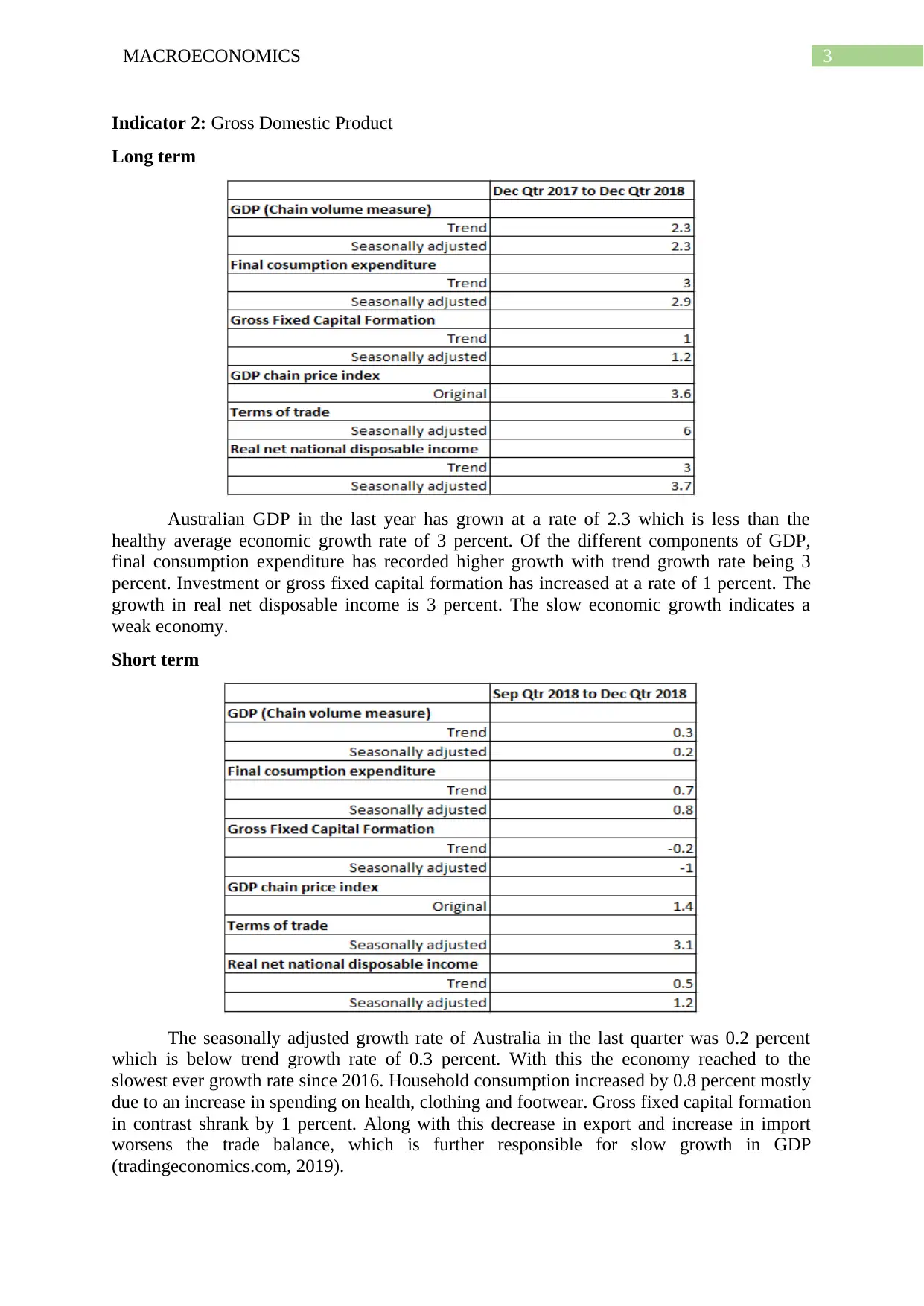
3MACROECONOMICS
Indicator 2: Gross Domestic Product
Long term
Australian GDP in the last year has grown at a rate of 2.3 which is less than the
healthy average economic growth rate of 3 percent. Of the different components of GDP,
final consumption expenditure has recorded higher growth with trend growth rate being 3
percent. Investment or gross fixed capital formation has increased at a rate of 1 percent. The
growth in real net disposable income is 3 percent. The slow economic growth indicates a
weak economy.
Short term
The seasonally adjusted growth rate of Australia in the last quarter was 0.2 percent
which is below trend growth rate of 0.3 percent. With this the economy reached to the
slowest ever growth rate since 2016. Household consumption increased by 0.8 percent mostly
due to an increase in spending on health, clothing and footwear. Gross fixed capital formation
in contrast shrank by 1 percent. Along with this decrease in export and increase in import
worsens the trade balance, which is further responsible for slow growth in GDP
(tradingeconomics.com, 2019).
Indicator 2: Gross Domestic Product
Long term
Australian GDP in the last year has grown at a rate of 2.3 which is less than the
healthy average economic growth rate of 3 percent. Of the different components of GDP,
final consumption expenditure has recorded higher growth with trend growth rate being 3
percent. Investment or gross fixed capital formation has increased at a rate of 1 percent. The
growth in real net disposable income is 3 percent. The slow economic growth indicates a
weak economy.
Short term
The seasonally adjusted growth rate of Australia in the last quarter was 0.2 percent
which is below trend growth rate of 0.3 percent. With this the economy reached to the
slowest ever growth rate since 2016. Household consumption increased by 0.8 percent mostly
due to an increase in spending on health, clothing and footwear. Gross fixed capital formation
in contrast shrank by 1 percent. Along with this decrease in export and increase in import
worsens the trade balance, which is further responsible for slow growth in GDP
(tradingeconomics.com, 2019).
Paraphrase This Document
Need a fresh take? Get an instant paraphrase of this document with our AI Paraphraser

4MACROECONOMICS
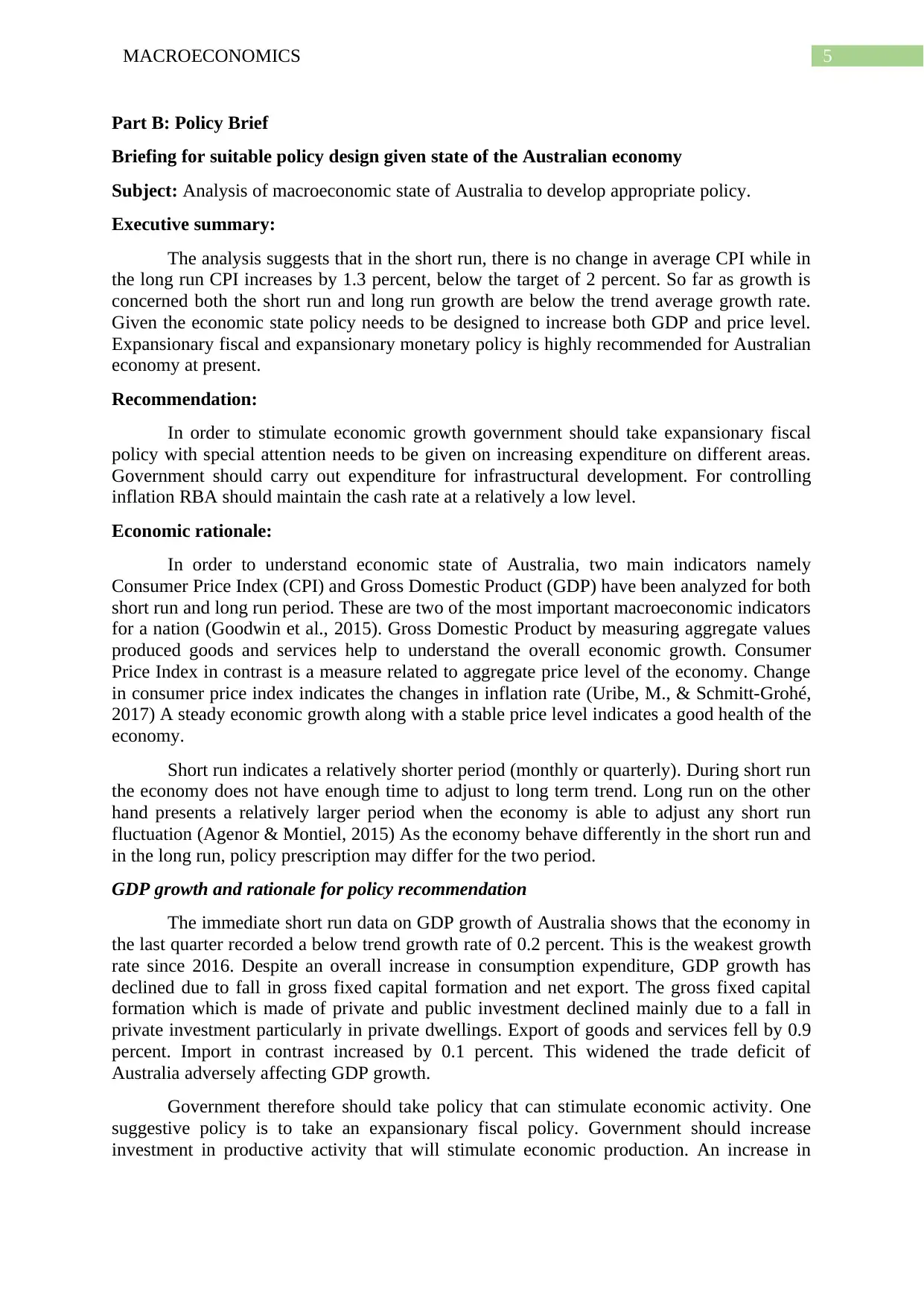
5MACROECONOMICS
Part B: Policy Brief
Briefing for suitable policy design given state of the Australian economy
Subject: Analysis of macroeconomic state of Australia to develop appropriate policy.
Executive summary:
The analysis suggests that in the short run, there is no change in average CPI while in
the long run CPI increases by 1.3 percent, below the target of 2 percent. So far as growth is
concerned both the short run and long run growth are below the trend average growth rate.
Given the economic state policy needs to be designed to increase both GDP and price level.
Expansionary fiscal and expansionary monetary policy is highly recommended for Australian
economy at present.
Recommendation:
In order to stimulate economic growth government should take expansionary fiscal
policy with special attention needs to be given on increasing expenditure on different areas.
Government should carry out expenditure for infrastructural development. For controlling
inflation RBA should maintain the cash rate at a relatively a low level.
Economic rationale:
In order to understand economic state of Australia, two main indicators namely
Consumer Price Index (CPI) and Gross Domestic Product (GDP) have been analyzed for both
short run and long run period. These are two of the most important macroeconomic indicators
for a nation (Goodwin et al., 2015). Gross Domestic Product by measuring aggregate values
produced goods and services help to understand the overall economic growth. Consumer
Price Index in contrast is a measure related to aggregate price level of the economy. Change
in consumer price index indicates the changes in inflation rate (Uribe, M., & Schmitt-Grohé,
2017) A steady economic growth along with a stable price level indicates a good health of the
economy.
Short run indicates a relatively shorter period (monthly or quarterly). During short run
the economy does not have enough time to adjust to long term trend. Long run on the other
hand presents a relatively larger period when the economy is able to adjust any short run
fluctuation (Agenor & Montiel, 2015) As the economy behave differently in the short run and
in the long run, policy prescription may differ for the two period.
GDP growth and rationale for policy recommendation
The immediate short run data on GDP growth of Australia shows that the economy in
the last quarter recorded a below trend growth rate of 0.2 percent. This is the weakest growth
rate since 2016. Despite an overall increase in consumption expenditure, GDP growth has
declined due to fall in gross fixed capital formation and net export. The gross fixed capital
formation which is made of private and public investment declined mainly due to a fall in
private investment particularly in private dwellings. Export of goods and services fell by 0.9
percent. Import in contrast increased by 0.1 percent. This widened the trade deficit of
Australia adversely affecting GDP growth.
Government therefore should take policy that can stimulate economic activity. One
suggestive policy is to take an expansionary fiscal policy. Government should increase
investment in productive activity that will stimulate economic production. An increase in
Part B: Policy Brief
Briefing for suitable policy design given state of the Australian economy
Subject: Analysis of macroeconomic state of Australia to develop appropriate policy.
Executive summary:
The analysis suggests that in the short run, there is no change in average CPI while in
the long run CPI increases by 1.3 percent, below the target of 2 percent. So far as growth is
concerned both the short run and long run growth are below the trend average growth rate.
Given the economic state policy needs to be designed to increase both GDP and price level.
Expansionary fiscal and expansionary monetary policy is highly recommended for Australian
economy at present.
Recommendation:
In order to stimulate economic growth government should take expansionary fiscal
policy with special attention needs to be given on increasing expenditure on different areas.
Government should carry out expenditure for infrastructural development. For controlling
inflation RBA should maintain the cash rate at a relatively a low level.
Economic rationale:
In order to understand economic state of Australia, two main indicators namely
Consumer Price Index (CPI) and Gross Domestic Product (GDP) have been analyzed for both
short run and long run period. These are two of the most important macroeconomic indicators
for a nation (Goodwin et al., 2015). Gross Domestic Product by measuring aggregate values
produced goods and services help to understand the overall economic growth. Consumer
Price Index in contrast is a measure related to aggregate price level of the economy. Change
in consumer price index indicates the changes in inflation rate (Uribe, M., & Schmitt-Grohé,
2017) A steady economic growth along with a stable price level indicates a good health of the
economy.
Short run indicates a relatively shorter period (monthly or quarterly). During short run
the economy does not have enough time to adjust to long term trend. Long run on the other
hand presents a relatively larger period when the economy is able to adjust any short run
fluctuation (Agenor & Montiel, 2015) As the economy behave differently in the short run and
in the long run, policy prescription may differ for the two period.
GDP growth and rationale for policy recommendation
The immediate short run data on GDP growth of Australia shows that the economy in
the last quarter recorded a below trend growth rate of 0.2 percent. This is the weakest growth
rate since 2016. Despite an overall increase in consumption expenditure, GDP growth has
declined due to fall in gross fixed capital formation and net export. The gross fixed capital
formation which is made of private and public investment declined mainly due to a fall in
private investment particularly in private dwellings. Export of goods and services fell by 0.9
percent. Import in contrast increased by 0.1 percent. This widened the trade deficit of
Australia adversely affecting GDP growth.
Government therefore should take policy that can stimulate economic activity. One
suggestive policy is to take an expansionary fiscal policy. Government should increase
investment in productive activity that will stimulate economic production. An increase in
⊘ This is a preview!⊘
Do you want full access?
Subscribe today to unlock all pages.

Trusted by 1+ million students worldwide
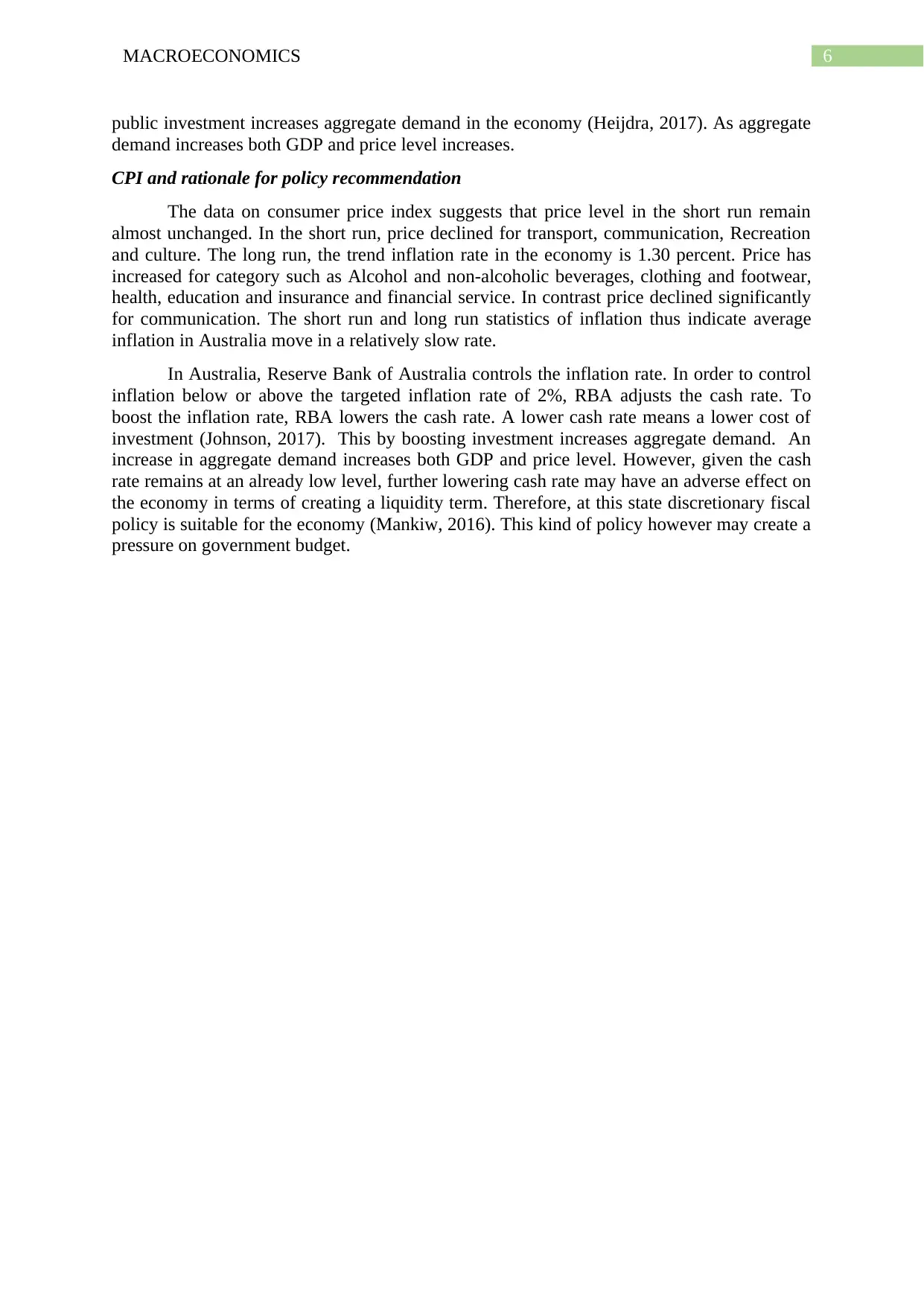
6MACROECONOMICS
public investment increases aggregate demand in the economy (Heijdra, 2017). As aggregate
demand increases both GDP and price level increases.
CPI and rationale for policy recommendation
The data on consumer price index suggests that price level in the short run remain
almost unchanged. In the short run, price declined for transport, communication, Recreation
and culture. The long run, the trend inflation rate in the economy is 1.30 percent. Price has
increased for category such as Alcohol and non-alcoholic beverages, clothing and footwear,
health, education and insurance and financial service. In contrast price declined significantly
for communication. The short run and long run statistics of inflation thus indicate average
inflation in Australia move in a relatively slow rate.
In Australia, Reserve Bank of Australia controls the inflation rate. In order to control
inflation below or above the targeted inflation rate of 2%, RBA adjusts the cash rate. To
boost the inflation rate, RBA lowers the cash rate. A lower cash rate means a lower cost of
investment (Johnson, 2017). This by boosting investment increases aggregate demand. An
increase in aggregate demand increases both GDP and price level. However, given the cash
rate remains at an already low level, further lowering cash rate may have an adverse effect on
the economy in terms of creating a liquidity term. Therefore, at this state discretionary fiscal
policy is suitable for the economy (Mankiw, 2016). This kind of policy however may create a
pressure on government budget.
public investment increases aggregate demand in the economy (Heijdra, 2017). As aggregate
demand increases both GDP and price level increases.
CPI and rationale for policy recommendation
The data on consumer price index suggests that price level in the short run remain
almost unchanged. In the short run, price declined for transport, communication, Recreation
and culture. The long run, the trend inflation rate in the economy is 1.30 percent. Price has
increased for category such as Alcohol and non-alcoholic beverages, clothing and footwear,
health, education and insurance and financial service. In contrast price declined significantly
for communication. The short run and long run statistics of inflation thus indicate average
inflation in Australia move in a relatively slow rate.
In Australia, Reserve Bank of Australia controls the inflation rate. In order to control
inflation below or above the targeted inflation rate of 2%, RBA adjusts the cash rate. To
boost the inflation rate, RBA lowers the cash rate. A lower cash rate means a lower cost of
investment (Johnson, 2017). This by boosting investment increases aggregate demand. An
increase in aggregate demand increases both GDP and price level. However, given the cash
rate remains at an already low level, further lowering cash rate may have an adverse effect on
the economy in terms of creating a liquidity term. Therefore, at this state discretionary fiscal
policy is suitable for the economy (Mankiw, 2016). This kind of policy however may create a
pressure on government budget.
Paraphrase This Document
Need a fresh take? Get an instant paraphrase of this document with our AI Paraphraser
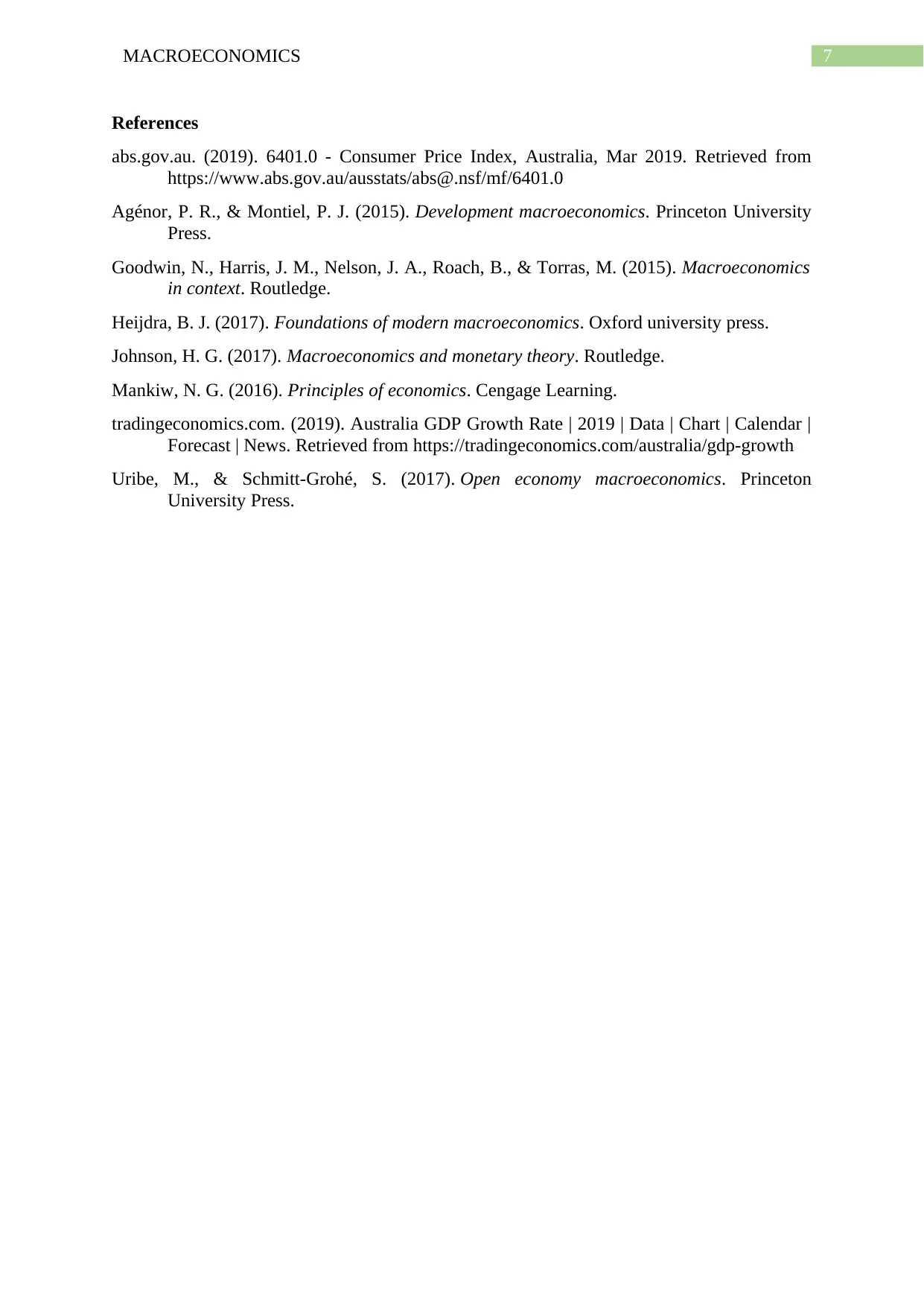
7MACROECONOMICS
References
abs.gov.au. (2019). 6401.0 - Consumer Price Index, Australia, Mar 2019. Retrieved from
https://www.abs.gov.au/ausstats/abs@.nsf/mf/6401.0
Agénor, P. R., & Montiel, P. J. (2015). Development macroeconomics. Princeton University
Press.
Goodwin, N., Harris, J. M., Nelson, J. A., Roach, B., & Torras, M. (2015). Macroeconomics
in context. Routledge.
Heijdra, B. J. (2017). Foundations of modern macroeconomics. Oxford university press.
Johnson, H. G. (2017). Macroeconomics and monetary theory. Routledge.
Mankiw, N. G. (2016). Principles of economics. Cengage Learning.
tradingeconomics.com. (2019). Australia GDP Growth Rate | 2019 | Data | Chart | Calendar |
Forecast | News. Retrieved from https://tradingeconomics.com/australia/gdp-growth
Uribe, M., & Schmitt-Grohé, S. (2017). Open economy macroeconomics. Princeton
University Press.
References
abs.gov.au. (2019). 6401.0 - Consumer Price Index, Australia, Mar 2019. Retrieved from
https://www.abs.gov.au/ausstats/abs@.nsf/mf/6401.0
Agénor, P. R., & Montiel, P. J. (2015). Development macroeconomics. Princeton University
Press.
Goodwin, N., Harris, J. M., Nelson, J. A., Roach, B., & Torras, M. (2015). Macroeconomics
in context. Routledge.
Heijdra, B. J. (2017). Foundations of modern macroeconomics. Oxford university press.
Johnson, H. G. (2017). Macroeconomics and monetary theory. Routledge.
Mankiw, N. G. (2016). Principles of economics. Cengage Learning.
tradingeconomics.com. (2019). Australia GDP Growth Rate | 2019 | Data | Chart | Calendar |
Forecast | News. Retrieved from https://tradingeconomics.com/australia/gdp-growth
Uribe, M., & Schmitt-Grohé, S. (2017). Open economy macroeconomics. Princeton
University Press.
1 out of 8
Related Documents
Your All-in-One AI-Powered Toolkit for Academic Success.
+13062052269
info@desklib.com
Available 24*7 on WhatsApp / Email
![[object Object]](/_next/static/media/star-bottom.7253800d.svg)
Unlock your academic potential
Copyright © 2020–2025 A2Z Services. All Rights Reserved. Developed and managed by ZUCOL.




